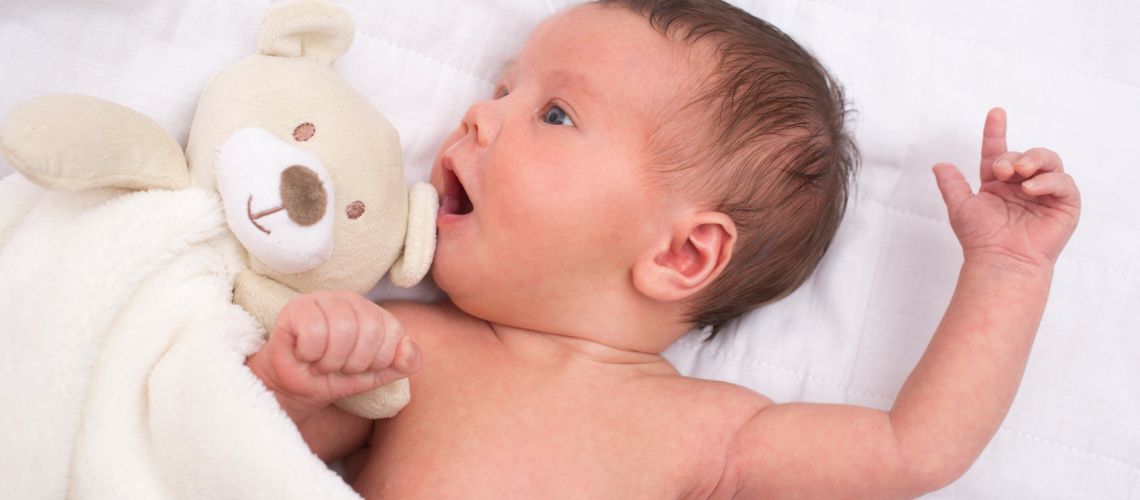By Sarah Bibi Patel – Good Night Consultant
We’ve all seen it – the absolutely adorable baby or toddler who has a favourite blankie/bear/security object that they cannot do without. I clearly remember Baby Bop and her blanky from my days of watching “Barney”. PS now I feel old J. When I was expecting my first born, those same images came back to me, and I dived into researching the concept.
What is a comfort item/lovey/security blanket?
Security objects are items that help a young child make the emotional transition from dependence to independence. It is something that reminds your baby of the comfort and security of mum and dad.
Since I am a sleep consultant, my research and focus is primarily on how security objects benefit your baby to sleep better.
These security objects, often referred to as a lovey, are meant to be soothing. As a parent, I found loveys to be a game-changer when it came to helping my baby self soothe. Interestingly, all 3 of my babies have different security objects. They each took to something different, this goes to show that just as each baby is unique, so too are their choices in which items soothe them the most.
What can you use to introduce as a comfort item?
The lovey you choose will depend on your child’s preference. However, in considering different options, your first priority should be SAFETY. It’s important to make sure that the lovey is safe and age-appropriate. It’s recommended that children do not sleep with any objects in their cot until they are 6 months of age, when they are able to move the lovey from their own faces. You want to ensure that the security object does not have any small pieces that could be a choking hazard.
Some little ones may prefer a small stuffed animal, others may prefer a lovey style blanket. Some babies prefer items with contrasting textures as well.
Why would you consider introducing such an item?
A comfort item can be a wonderful sleep aid – it helps babies and toddlers build confidence and security. It also helps to ease separation anxiety! It also goes a long way in providing additional comfort to your baby during traveling, illness and times of stress. It can be a sustainable sleep association for your baby. Once they know that they use it for sleep, it helps them to make that journey to sleep with ease. My family always joked that when we came to stay over for holidays, we had to bring a whole zoo with! They were not far from the truth: my son had a bear, a scruffy puppy AND a taglet that he loved to sleep with, my one twin had her bear and my other twin loves her bunny. It was something we could NOT forget to bring, but I really didn’t mind, as I witnessed the confidence and independence these items helped to build within my babies.
When should you introduce a lovey?
Attachment to an object often develops toward the end of the first year. There is no “right or wrong age”. The most common time to introduce a lovey is around 6 months of age. A strong attachment to a lovey peaks at 18-24 months, and then starts to diminish from about 3 years old. By five and a half years old, fewer than 8 percent of children are still attached to their lovey.
It’s also important to note that The American Academy of Pediatrics states that infants under the age of one year old should not have any objects in their cot. You can do a slow introduction by allowing monitored playtime with it, allow them to hold onto their lovey during a milk feed or during a nap/bedtime routine.
How do I introduce a lovey?
So now you have an item that is safe and your baby is now at the appropriate age. How do you get them to attach to this item?
- You want your baby to see this item as an extension of you. Every time you feed and cuddle your baby put the comfort object between you and your baby.
- You can squeeze some of your breastmilk on it to help baby associate it with you. Alternatively, keep the item with your pyjamas for a couple of nights so that it smells of mom.
- Make sure to always keep it with you during the times you are offering hugs, love and cuddles.
- Show the object lots of love yourself, comment on how soft it is, stroke it and say how calm it helps you to feel.
- If your baby throws or pushes the object away simply calmly put it back (repeatedly).
- At nap time and bedtime snuggle the comfort object next to the baby while they are going to sleep (for under 6-month-olds remove once they are asleep).
- For older babies and toddlers (over 12 months) make sure that they have free access to the object all night, for younger babies just while you are present to supervise.
- For babies in day care, make sure the comfort object is always with them as needed during the day.
- I would ALWAYS recommend buying 2 of the same items. A lovey gets dirty and needs to be washed occasionally. I lost my sons taglet in Exclusive Books one day – it fell from the pram and we had to retrace our steps in the mall to find it! Save yourself the stress, and keep a spare or 2 of the same lovey!
- As with most things sleep related, consistency is always key! You can expect a period of around 4 to 6 weeks of doing this daily before your baby forms a connection with their comfort object. Remember, they aren’t magic. It takes time for them to associate them with you. Around two thirds of babies will eventually form a good bond with a comfort object.
- If despite ALL of your efforts, your baby does NOT take to a lovey, it is not the end of the world! Your baby can still sleep well and gain independence and security without it.
Do I need to get rid of it in the future?
Many parents are concerned about creating a situation where a child becomes overly dependent on their lovey. Children will develop an attachment to their lovey, but that is no different from you relying on your favourite pillow for sleep! As children get older and become more socially aware, their dependency on their lovey diminishes. This typically happens as early as the pre-school years and as late as the first few years of school. However, it is fine to let your child’s attachment to that object fade over time – there is no need to make your child give it up before they are ready.
My children all still use their comfort items exclusively for sleep. Those items have remained the same since they were babies. It’s been an amazing journey to witness how their attachment developed, intensified and is now slowly diminishing. It’s been even more incredible to witness the growth, confidence and security these little bears and bunnies have encouraged in them!
Resources:
http://www.healthofchildren.com/S/Security-Objects.html#ixzz7XRexA852
#sleeptraining

